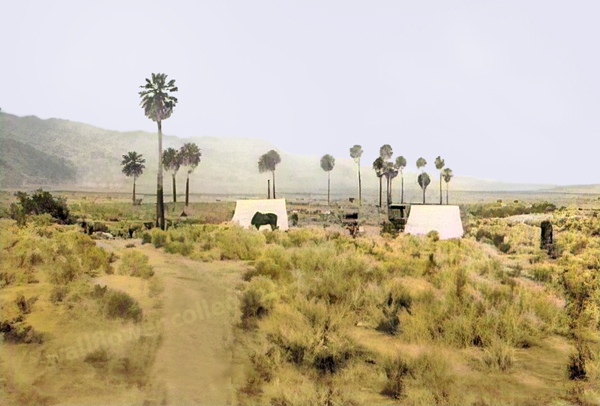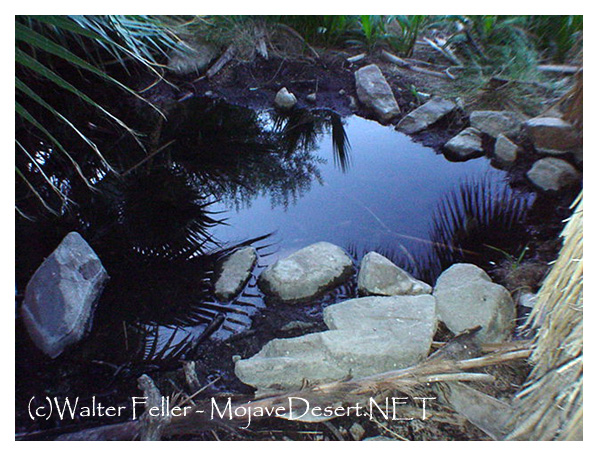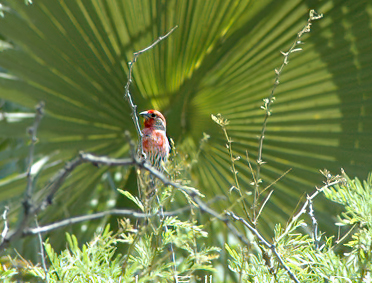Joshua Tree National Park -
Oasis of Mara
In deserts the presence of water, that rarest of desert commodities, allows life to flourish and
provides an
oasis
for natural and human activity. The Oasis of Mara is a cornerstone of the
Joshua Tree National Park story.

Oasis of Mara possibly 1904
The oasis was first settled by the
Serrano
who called it Mara, meaning "the place of little springs
and much grass." Legend holds they came to the oasis because a medicine man told them it was a good
place to live and that they would have many boy babies. The medicine man instructed them to plant a
palm tree each time a boy was born. In the first year, the Serrano planted 29 palm trees at the oasis. The
palms also provided the Serrano with food, clothing, cooking implements, and housing. In addition, the palms
are
habitat
for a wide variety of
desert creatures
from colorful orioles to the palm-boring beetle.

Oasis of Mara - 2016
Early American survey parties arrived at the Oasis of Mara in the 1850s and found the area under cultivation
by the Serrano. Corn, beans, pumpkins, and squash were all grown with the life-giving waters that rise at
the oasis along the Pinto Mountain Fault. The
Chemehuevi
settled at the Oasis in 1867 and intermingled peacefully with the Serrano.

Water in spring at oasis - 2006
By 1870,
prospectors
attracted to California by the discoveries at Sutter's Mill had drifted into the
desert looking for gold. The Anaconda Mine began operation south of the Oasis in 1874. The
Lost Horse,
the
Desert Queen,
and other claims soon followed. Trees began to be cut at the Oasis, and water
siphoned away to support the growing mining operations.

Water in spring at oasis - 2006
On the heels of the miners,
cattlemen
moved to the area in the 1880s to take advantage of the high
desert grasslands of the Pinto and Little San Bernardino Mountains. The McHaney brothers ran an
active cattle trade that was alleged to include stolen cattle that they pastured in isolated rocky
coves near
Hidden Valley.

Oasis of Mara 2010
Bill McHaney became the first non-Indian to live at the Oasis in 1879. Later, Jack Rankin
and Billy Neaves built an adobe house at the east end of the Oasis. It stood for over 40 years
and served as a residence, a stage line stop, and a meeting place. The Barker and Shays Cattle
Company dug a 600-gallon well around 1900 for use by the growing population. A 1902 census found
37 Serrano and Chemehuevi living at the Oasis. As more non-Indians arrived, the Indian families
began to drift away, and by 1913, the Serrano and Chemehuevi were all gone.
Following World War I, the town of
Twentynine Palms
saw an influx of veterans suffering from the
effects of gas inhalation, drawn to the area by its warm,
arid
climate.
The establishment
in 1936 of a vast stretch of the desert above town as Joshua Tree National Monument drew more
people to the area. The Twentynine Palms Corporation donated the Oasis of Mara to the National
Park Service in 1950 to use as its headquarters and primary visitor center.
Today, more than 140,000 people annually visit the Oasis Visitor Center where they receive
information about the park and learn about its natural and human history. Many visitors also
take the opportunity to walk the
Oasis of Mara nature trail.
Source: National Park Service Brochure

Oasis of Mara Nature Trail

Chemehuevi

Elizabeth Campbell

Twentynine Palms
